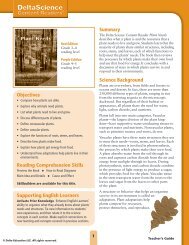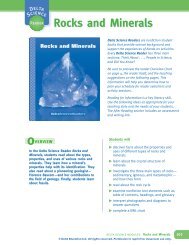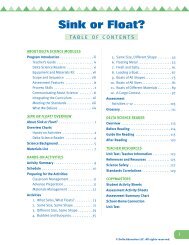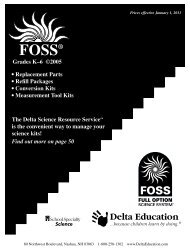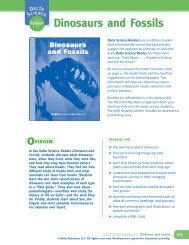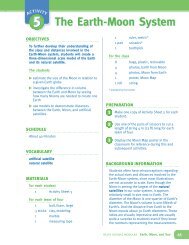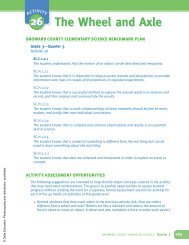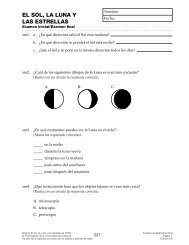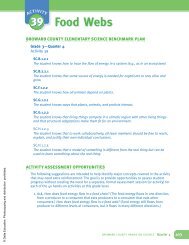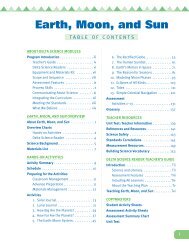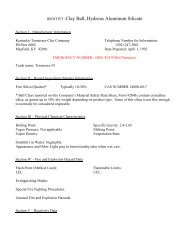Erosion -Teacher's Guide Table Of Contents ... - Delta Education
Erosion -Teacher's Guide Table Of Contents ... - Delta Education
Erosion -Teacher's Guide Table Of Contents ... - Delta Education
Create successful ePaper yourself
Turn your PDF publications into a flip-book with our unique Google optimized e-Paper software.
Process Skillsobserve, hypothesize, experiment,inferVocabularyacid rain, chemical weathering, oxidation,physical weathering, weathering<strong>Erosion</strong><strong>Delta</strong> ScienceReaderpages 5–6make and use models, observe,define based on observationsalluvial fan, base level, delta, erosion, floodplain,levee, meander, sedimentpages 8, 9hypothesize, experiment, usevariables, predict, comparesoil pages 7, 12, 14measure; collect, record, display,or interpret data; infermeasure, use variables, observe,compare, inferdeposition, particle pages 7, 8, 9slope, variable page 11make and use models; collect,record, display, or interpret data;inferdike, runoff page 15measure; compare; collect, record,display, or interpret data; inferpermeable, saturated pages 7, 8predict, observe, compare,communicatepages 7, 14observe, compare, infer page 9predict; compare; make and usemodels; collect, record, display, orinterpret databreakwater, tidal action, wave page 10predict, observe, infer dune, windbreak page 12communicate, make and usemodels, observe, comparedebris, glacial till, glacier page 13See the following page for the <strong>Delta</strong>Science Reader Overview Chart.<strong>Erosion</strong> 3© <strong>Delta</strong> <strong>Education</strong> LLC. All rights reserved.
ACTIVITY SUMMARYIn this <strong>Delta</strong> Science Module, studentsinvestigate erosion—how it is caused and howits effects can be reduced.ACTIVITY 1 Students are introduced toweathering, the constant breaking down—physically or chemically—of rocks and mineralson Earth’s surface. They record examples ofphysical weathering that they observe on theirway to and from school. They investigatechemical weathering by observing a mild acidsolution (vinegar, used to simulate acid rain)dissolving a mineral sample (calcite).ACTIVITY 2 Students are introduced to erosion,the carrying away of weathered materials. Theyset up stream tables, simulate the movement ofwater in a stream, and identify landformscreated by material that was carried away ordeposited by the moving water.ACTIVITY 3 Students find out how vegetationaffects erosion by running water over two soilsurfaces—one bare and one covered withgrass—and comparing the amount of erosionthat occurs on each.ACTIVITY 4 Students investigate how aparticle’s size, weight, and compositiondetermine when and where it will be depositedby moving water. They conduct “rock races” andobserve the deposition characteristics of earthmaterials.ACTIVITY 5 Students discover that increasingthe slope (incline) of the stream table increasesthe speed of the moving water and, therefore,the amount of erosion of the streambedmaterial.ACTIVITY 6 Students simulate floodconditions. They observe that increasing therate of flow of water running over thestreambed increases the extent of erosion.ACTIVITY 7 Students pour water over severaldifferent types of earth materials to determinethe permeability of each. They relate thischaracteristic to the material’s tendency toproduce runoff—water that is unable to passthrough the ground. Thus they discover that thetype of soil in an area affects its likelihood to beflooded.ACTIVITY 8 Students investigate and comparethe erosion characteristics of two types of soil:clay and potting. The results are then comparedwith those obtained in Activity 6 using sand.ACTIVITY 9 Students apply what they havelearned about the patterns of erosion and thecharacteristics of different types of earthmaterials to determine where, along the path ofa hypothetical river, each of four river sedimentsamples was taken. Students examine thesamples and study a map describing severalareas along the river in order to identify the sitewhere each sample was most likely obtained.ACTIVITY 10 Stream tables become beaches asstudents investigate shoreline erosion causedby waves. They design and constructbreakwaters and evaluate their effectiveness inreducing shoreline erosion.ACTIVITY 11 Students investigate anothercontributor to erosion: wind. Studentsdemonstrate how wind can erode sand. Thenthey design and build a windbreak and test itseffectiveness at protecting their “house on thebeach.”ACTIVITY 12 Students investigate the erosioncaused by the movement of huge masses ofslow-moving ice—glaciers. The studentsobserve the erosion caused by a debris-filledglacier, as well as the deposition of glacialtill—unsorted and unstratified rock materialsleft under a moving glacier or along its sides asit melts.<strong>Erosion</strong>© <strong>Delta</strong> <strong>Education</strong> LLC. All rights reserved.9



